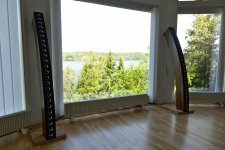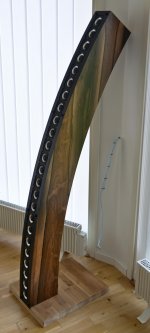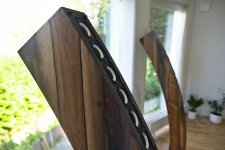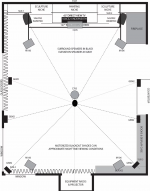One thing I *may* have noticed between 3 and 5 banks is where the sound seems to come from in the vertical plane. With 5 banks the sound seems to come directly in front of where my head is, either sitting on the floor or standing up. It sounds like I'm listening to speakers that are directly in front of me at head height.
With 3 banks it sounds like the sound is coming from the center of the array. I'd describe it as a Big Sound. If I sit on the floor it sounds like the speakers are a little above my head. Although, if I stand it isn't as noticeable.
Also, I might be imagining things. Or I didn't do a good job controlling the 3 banks.
I can't say I like one better than the other at all times. I played a Yanni song which I'd categorize as "magical orchestra" and it was a better experience on the 3 bank because the music had a Big Sound, larger than life.
The reason I'm able to switch between 3 and 5 banks is that I individually amped each speaker and control the bank shading with DSP. I also used a flat array (DSP time delayed) rather than a physically curved array. Consequently, a physically curved array might behave differently. According to Don Keele's papers, a physically curved array should behave better than a flat time delayed array.
With 3 banks it sounds like the sound is coming from the center of the array. I'd describe it as a Big Sound. If I sit on the floor it sounds like the speakers are a little above my head. Although, if I stand it isn't as noticeable.
Also, I might be imagining things. Or I didn't do a good job controlling the 3 banks.
I can't say I like one better than the other at all times. I played a Yanni song which I'd categorize as "magical orchestra" and it was a better experience on the 3 bank because the music had a Big Sound, larger than life.
The reason I'm able to switch between 3 and 5 banks is that I individually amped each speaker and control the bank shading with DSP. I also used a flat array (DSP time delayed) rather than a physically curved array. Consequently, a physically curved array might behave differently. According to Don Keele's papers, a physically curved array should behave better than a flat time delayed array.
Last edited:
They are done! (Almost... still wish to build a speaker grill so I can cover the elements when needed.)
I am happy with how they turned out, one out of the 48 elements was bad (I assume from factory as there was no visible damage). It sounded very bad when playing high frequencies (could make the bad sound disappear by lightly placing my finger on one of the elements). After changing that one everything was awesome!
Now I just need to get a microphone and measure them and try some DSP😀
Jim, have you measured your CBT24 speakers?
I am happy with how they turned out, one out of the 48 elements was bad (I assume from factory as there was no visible damage). It sounded very bad when playing high frequencies (could make the bad sound disappear by lightly placing my finger on one of the elements). After changing that one everything was awesome!
Now I just need to get a microphone and measure them and try some DSP😀
Jim, have you measured your CBT24 speakers?
Attachments
hka,
Your arrays are gorgeous! You have an excellent room for the CBT24 arrays and you should be pleased with the results. They should provide excellent sound within your listening room.
I have not measured my arrays for their in-room frequency response per se. But I do use the Audyssey MultiEQ XT32 system for room EQ and correction. It involves 8 in-room measurements that calibrates for optimum performance within the room. The Audysssey system is embodied within the Denon AVR-X3600H receiver that I use to amplify my system. An omni-directional microphone is provided with the receiver to facilitate the measurements. The AVR-X3600H also provides the crossover to each of the stereo powered sub woofers that I use. Thus the measurements compensate for the arrays, the sub woofers and the room/integration.
Let us hear your impressions about the sound of your arrays.
Your arrays are gorgeous! You have an excellent room for the CBT24 arrays and you should be pleased with the results. They should provide excellent sound within your listening room.
I have not measured my arrays for their in-room frequency response per se. But I do use the Audyssey MultiEQ XT32 system for room EQ and correction. It involves 8 in-room measurements that calibrates for optimum performance within the room. The Audysssey system is embodied within the Denon AVR-X3600H receiver that I use to amplify my system. An omni-directional microphone is provided with the receiver to facilitate the measurements. The AVR-X3600H also provides the crossover to each of the stereo powered sub woofers that I use. Thus the measurements compensate for the arrays, the sub woofers and the room/integration.
Let us hear your impressions about the sound of your arrays.
Last edited:
Wow, Sweden has some beautiful scenery. Your CBTs look great.
I'd like to know if my experience with a Flat 3 Bank CBT carries over to the physically curved CBT. I'm not sure how to describe it, but with 5 Banks I perceive a more vertically defined soundfield. That means I hear the music as though it is coming from speakers placed directly at ear level whether I am sitting or standing in front of the array. With 3 Banks it sounded like the soundfield always came from the center of the array.
I don't think the difference is very important in terms of enjoyment. Both are enjoyable. In fact, the 3 Bank might even be more enjoyable in home theater because I'd describe the soundfield as enveloping.
I wish more people built CBTs. I'm certainly glad you did.
I'd like to know if my experience with a Flat 3 Bank CBT carries over to the physically curved CBT. I'm not sure how to describe it, but with 5 Banks I perceive a more vertically defined soundfield. That means I hear the music as though it is coming from speakers placed directly at ear level whether I am sitting or standing in front of the array. With 3 Banks it sounded like the soundfield always came from the center of the array.
I don't think the difference is very important in terms of enjoyment. Both are enjoyable. In fact, the 3 Bank might even be more enjoyable in home theater because I'd describe the soundfield as enveloping.
I wish more people built CBTs. I'm certainly glad you did.
I have done some listening now 🙂 I really like the sound, very clean and sounds more like live music than regular speakers manage. But for some music it would be nice with a bit more bass.
For fun I took a Zoom H1 microphone, placed it 2 meters away from the spekers, 1 m from the floor and played some white noise to get some rough estimate of how the frequency response looks. Looks like there is very little under about 140 Hz. Not accurate measure by any means but shows a little. Seems to be a hump at 4kHz as well.
bradleypnw: If you mean that with 5 banks it felt like you were listening to music in headphones and that the music more feels like it comes from somewhere between the speakers for 3 banks. Then I think your impression is similar to mine 🙂 It really doesn't sound like headphones even thought the sound follows you around.
For fun I took a Zoom H1 microphone, placed it 2 meters away from the spekers, 1 m from the floor and played some white noise to get some rough estimate of how the frequency response looks. Looks like there is very little under about 140 Hz. Not accurate measure by any means but shows a little. Seems to be a hump at 4kHz as well.
bradleypnw: If you mean that with 5 banks it felt like you were listening to music in headphones and that the music more feels like it comes from somewhere between the speakers for 3 banks. Then I think your impression is similar to mine 🙂 It really doesn't sound like headphones even thought the sound follows you around.
Attachments
Last edited:
I don't experience a headphone sensation. If I change my horizontal position my stereo imaging will shift just like like normal speakers.
But if I change my vertical plane of listening a 5 Bank will sound like the speakers are always at ear level. A 3 Bank will sound like the speakers are located in the center of the array.
Maybe another way to say it is that a 5 Bank sounds more like normal speakers. A 3 Bank sounds larger than life to me, more like listening to a movie theater system where voices sound big (but much better quality.)
But if I change my vertical plane of listening a 5 Bank will sound like the speakers are always at ear level. A 3 Bank will sound like the speakers are located in the center of the array.
Maybe another way to say it is that a 5 Bank sounds more like normal speakers. A 3 Bank sounds larger than life to me, more like listening to a movie theater system where voices sound big (but much better quality.)
I'm pleased to hear hka's impressions of his system. His comments are akin to the impressions I have of my system after almost 3 years of listening.
His comment on needing more bass is understandable given that my Modified CBT24 arrays were intended to be used with dual sub woofers to address their bass response. The array towers are sealed enclosures which essentially produce sound down to 140 Hz or so and little sound below that point. Now you can increase the bass sound a bit by boosting the frequency response of the towers response below 140 Hz. But you would be asking too much of the superb SB65 drivers if too much boost is added.
Enter use of sub woofers to enhance the bass and cover the lowest two octaves--35 to 70 Hz and 70 to 140 Hz regions: I use two powered sub woofers. My subs use 12 inch diameter drivers and have amplifiers to help equalize their output. One sub in my current system is my trusty DIY 2 cubic foot enclosure unit which has an Eminence LAB12 driver and with a bass boosted Dayton Audio SPA250 amplifier. My other sub is a SVS Sound SB1000 (not a DIY creation) unit which has a 12 inch diameter driver with a 300watts (720 peak watts) amplifier. My receiver (see Posting #43 in this thread) has internal crossovers (set at 125 Hz in my system) that provides the signal inputs to the two subs.
Thus the need for bass can be solved.
His comment on needing more bass is understandable given that my Modified CBT24 arrays were intended to be used with dual sub woofers to address their bass response. The array towers are sealed enclosures which essentially produce sound down to 140 Hz or so and little sound below that point. Now you can increase the bass sound a bit by boosting the frequency response of the towers response below 140 Hz. But you would be asking too much of the superb SB65 drivers if too much boost is added.
Enter use of sub woofers to enhance the bass and cover the lowest two octaves--35 to 70 Hz and 70 to 140 Hz regions: I use two powered sub woofers. My subs use 12 inch diameter drivers and have amplifiers to help equalize their output. One sub in my current system is my trusty DIY 2 cubic foot enclosure unit which has an Eminence LAB12 driver and with a bass boosted Dayton Audio SPA250 amplifier. My other sub is a SVS Sound SB1000 (not a DIY creation) unit which has a 12 inch diameter driver with a 300watts (720 peak watts) amplifier. My receiver (see Posting #43 in this thread) has internal crossovers (set at 125 Hz in my system) that provides the signal inputs to the two subs.
Thus the need for bass can be solved.
Last edited:
Very nice build, hka !
I think it was smart to follow Jim's driver selection, and imagine you will really like them.
Especially when your sub(s) are brought in to play.
@ bradleypnw,
I built both straight-line and CBT arrays using 24 TC9's.
Drivers were wired as 6 banks of 4 drivers each.
I found the CBT, using amplitude shading per standard recommendations, had an apparent acoustic center about 40% of the CBT's height up from the floor.
That location was fairly locked in, no matter what listening height, angle, or distance.
I mimicked the CBT with the straight line.
Used delays that matched the z-axis lean-back inherent in the CBT's geometry, along with the same CBT amplitude shading.
The tonal result was close to the CBT, but the apparent acoustic center would move up and down with changes in listener position height, angle, and distance.
My takeaway was I guess it's hard to mimic a CBT with just delays and amplitude shading....
I think it was smart to follow Jim's driver selection, and imagine you will really like them.
Especially when your sub(s) are brought in to play.
@ bradleypnw,
I built both straight-line and CBT arrays using 24 TC9's.
Drivers were wired as 6 banks of 4 drivers each.
I found the CBT, using amplitude shading per standard recommendations, had an apparent acoustic center about 40% of the CBT's height up from the floor.
That location was fairly locked in, no matter what listening height, angle, or distance.
I mimicked the CBT with the straight line.
Used delays that matched the z-axis lean-back inherent in the CBT's geometry, along with the same CBT amplitude shading.
The tonal result was close to the CBT, but the apparent acoustic center would move up and down with changes in listener position height, angle, and distance.
My takeaway was I guess it's hard to mimic a CBT with just delays and amplitude shading....
@ bradleypnw,
I built both straight-line and CBT arrays using 24 TC9's.
Drivers were wired as 6 banks of 4 drivers each.
I found the CBT, using amplitude shading per standard recommendations, had an apparent acoustic center about 40% of the CBT's height up from the floor.
That location was fairly locked in, no matter what listening height, angle, or distance.
I mimicked the CBT with the straight line.
Used delays that matched the z-axis lean-back inherent in the CBT's geometry, along with the same CBT amplitude shading.
The tonal result was close to the CBT, but the apparent acoustic center would move up and down with changes in listener position height, angle, and distance.
My takeaway was I guess it's hard to mimic a CBT with just delays and amplitude shading....
It's strange that the perception of the acoustic center changes. I wonder what causes that.
My reasoning is the physically curved floor and ceiling reflections can't be mimicked with a straight vertical line.
I guess only geometry takes care of geometry, because it has 3 dimensions.
Whereas delay is just one of the dimensions.
I guess only geometry takes care of geometry, because it has 3 dimensions.
Whereas delay is just one of the dimensions.
Good point mark100, that the drivers are rotated must change how the sound behaves for sure.
Ok, so I have started to think more about subwoofer😀 Could someone tell me if placing a subwoofer behind the array would be an ok idea. As I need it up to about 150 Hz (thinking about crossover at 200 Hz maybe), I understand that it should be placed as close as possible to the full range speaker (and that position matters less the lower the frequency).
Ok, so I have started to think more about subwoofer😀 Could someone tell me if placing a subwoofer behind the array would be an ok idea. As I need it up to about 150 Hz (thinking about crossover at 200 Hz maybe), I understand that it should be placed as close as possible to the full range speaker (and that position matters less the lower the frequency).
Attachments
Good point mark100, that the drivers are rotated must change how the sound behaves for sure.
Ok, so I have started to think more about subwoofer😀 Could someone tell me if placing a subwoofer behind the array would be an ok idea. As I need it up to about 150 Hz (thinking about crossover at 200 Hz maybe), I understand that it should be placed as close as possible to the full range speaker (and that position matters less the lower the frequency).
No problems at all! I've tried sub locations in my own cbt experiments in another thread: CBT Dipole with SB65WBAC25-4 and I found that if I place the woofer just behind the array then crossing at 150-200 hz is no problem at all. And since my dipole SB65 should in theory have less low frequency extension than your monopole version you could possibly cross even lower. I believe Jim Griffin said he crossed at 120 hz but I could be wrong.
In my experiments I've been peaking towards sideways mounted woofers though because I find it kind of a shame to take the sleek and slim design and widen it visually with a huge square sub. This thread Active 4 way with MiniDSP and UCD uses 2x of the the very shallow 10" SB acoustics subwoofer drivers while still having a not that wide speaker.
In my case I already have the sub drivers and they are not that shallow so the solution I'm going to test is to mount them sideways on top of each other like in Gainphiles compact dipole: Gainphile: S20-Z Compact Open Baffle using Zaph Kit
Last edited:
hka,
I suspect that the ground plane CBT arrays would work OK (given OllBoll's experience) with the sub woofers behind the towers. My usual sub woofer location is near the arrays but with flexible positioning so that I could move the subs for optimizing room/sub integration.
Thus my subs have always been separate enclosures--not merged with tower speakers for instance. That makes me a regular sort of guy--staying within the normal configuration.
My subs cross over at 125 Hz as I mentioned earlier in this thread.
I've seen subs packaged so that they fire sideways in the room versus tower arrays so I guess other placements could be considered.
I suspect that the ground plane CBT arrays would work OK (given OllBoll's experience) with the sub woofers behind the towers. My usual sub woofer location is near the arrays but with flexible positioning so that I could move the subs for optimizing room/sub integration.
Thus my subs have always been separate enclosures--not merged with tower speakers for instance. That makes me a regular sort of guy--staying within the normal configuration.
My subs cross over at 125 Hz as I mentioned earlier in this thread.
I've seen subs packaged so that they fire sideways in the room versus tower arrays so I guess other placements could be considered.
Good point mark100, that the drivers are rotated must change how the sound behaves for sure.
Ok, so I have started to think more about subwoofer😀 Could someone tell me if placing a subwoofer behind the array would be an ok idea. As I need it up to about 150 Hz (thinking about crossover at 200 Hz maybe), I understand that it should be placed as close as possible to the full range speaker (and that position matters less the lower the frequency).
The illustration looks like the subwoofer is physically attached to the array. Here's a JBL wave length chart. At 150Hz the wave lengths will be over 7 feet long. At 250Hz they will still be 4.5 feet long. Consequently, I think you might be better off keeping the subs separate so you can position them to optimize low frequency room response. But if you decide to place them near the arrays you have a lot of wiggle room at those frequencies.
https://www.jdbsound.com/art/frequency wave length chart 2013.pdf
Here's an illustration for Floyd Toole's house. He places his subs in the four corners because he uses a specific Harman/JBL technique called Sound Field Management. Earl Geddes uses a different technique but I don't have an illustration of his room.
Attachments
Last edited:
This is what Geddes says wrt sub placement.
Multiple Subwoofer after Geddes.
Put one sub in a corner close to the mains. The second sub is a lot more flexible as to its location, but it should not be in a corner. Side wall or back wall, near the midpoint is a good idea. Put the third sub wherever you can that is not too close to the other two. It's a good idea to get one of them off of the floor.
Multiple Subwoofer after Geddes.
Ah yes sorry about the drawing, not meant to be attached.
Just read through this thread: Small active 3-way floor stander with a punch
So now I am a bit curious about SB Acoustics low profile subs. And making something thin and high that can be placed behind the arrays but side firing.
I dont really wish to put them on the sides of the arrays due to the windows in my listening room 🙂
Just read through this thread: Small active 3-way floor stander with a punch
So now I am a bit curious about SB Acoustics low profile subs. And making something thin and high that can be placed behind the arrays but side firing.
I dont really wish to put them on the sides of the arrays due to the windows in my listening room 🙂
So maybe something like this, with height adjusted according to how much volume I need (and again, not physically attached to the arrays, just placed close behind).
But I think it is time I learn how to Vituixcad🙂
Just want to say it looks really cool!
hka,
I like your idea about inserting the subs in the space behind the arrays.
Before you become too involved with Vituixcad, you might investigate the proposed sub woofer design you suggested. Some box modeling of the SW26DBAC76 (if that is the first choice you are considering) in various enclosures (sealed, ported, etc.) would be useful to determine their performance vs your needs. The available volume behind the array enclosures can be calculated and compared vs. performance of the box models.
More fun in your future. At least you will have the arrays playing in the background while you work.
Jim
I like your idea about inserting the subs in the space behind the arrays.
Before you become too involved with Vituixcad, you might investigate the proposed sub woofer design you suggested. Some box modeling of the SW26DBAC76 (if that is the first choice you are considering) in various enclosures (sealed, ported, etc.) would be useful to determine their performance vs your needs. The available volume behind the array enclosures can be calculated and compared vs. performance of the box models.
More fun in your future. At least you will have the arrays playing in the background while you work.
Jim
Last edited:
- Home
- Loudspeakers
- Full Range
- Modified CBT24






